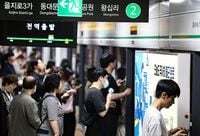On the morning of July 4, 2025, Seoul’s bustling subway system faced a major disruption that left thousands of commuters stranded and frustrated. At approximately 7:50 AM, a signal failure occurred at Seoul National University Station on Line 2, one of the city’s busiest subway lines. This malfunction, caused by a misalignment in the switch system that controls train directions, brought train operations in both directions to a halt during the critical rush hour.
The switch, a crucial signal device responsible for guiding trains onto the correct tracks, failed to operate as intended. According to the Seoul Transportation Corporation, this misalignment created operational chaos, forcing the immediate suspension of train services at the affected station. The corporation quickly responded, implementing emergency measures to minimize the disruption. By 8:09 AM, officials announced that the issue had been addressed and trains began moving again, albeit at a reduced speed and with continued delays.
Despite the swift response, the interruption caused significant inconvenience for commuters. Many faced extended wait times and overcrowded platforms as trains remained stationary or operated slowly along the line. Social media platforms, particularly X (formerly Twitter), were flooded with posts from frustrated passengers sharing their experiences. Comments ranged from exasperated remarks like “This signal failure at this hour is unbelievable,” to concerns about being late for work and the unbearable crowding on platforms.
Kim Bo-min, a commuter who transfers at Dongdaemun Stadium Station, shared her ordeal: “Because of the delayed trains on Line 2, I was about 20 minutes late to work. The platform was so crowded and hot, it made the wait even more exhausting.” Similarly, Kim Young-soo, waiting at Seocho Station, described how the trains had been stopped for roughly 20 minutes, leading to long lines stretching up the station stairs. “I missed my usual train to transfer to the Sinbundang Line at Gangnam Station, which made me very late,” he said.
Passengers aboard the trains were not spared either. Lee Mo, who was on a train stopped at Jamsil Station, recounted how the train doors remained open for over ten minutes while the train was stationary. “It was incredibly hot and packed with people,” Lee said, highlighting the discomfort experienced during the delay.
The Seoul Transportation Corporation explained that the signal failure stemmed from a discrepancy between the inner and outer line switches at Seoul National University Station. This mismatch disrupted the smooth flow of trains, forcing the suspension of service to ensure safety. To manage the situation, the corporation replaced the automatic signaling with manual signals, enabling trains to resume operation cautiously.
Despite the restoration of service by 8:09 AM, the ripple effects of the incident were felt throughout the morning. Even after trains began moving again, delays persisted, and the usual punctuality of Line 2 was compromised. By 9:20 AM, operations were still running behind schedule, and the crowded conditions on platforms remained a concern.
This event is a stark reminder of how critical infrastructure components, like switch systems, play a vital role in the daily functioning of urban transit. The failure not only disrupted thousands of commutes but also exposed vulnerabilities in the system’s ability to handle sudden technical issues during peak hours.
Seoul’s subway system, known for its efficiency and high passenger volumes, depends heavily on the seamless coordination of its signaling mechanisms. When these systems falter, even briefly, the consequences cascade rapidly, affecting not only individual commuters but also the broader rhythm of the city’s daily life.
As the city continues to grow and rely more on public transportation, the importance of maintaining and upgrading these critical control systems becomes ever more apparent. The Seoul Transportation Corporation has pledged to investigate the cause of the switch misalignment thoroughly and to implement measures to prevent similar incidents in the future.
The morning’s disruption, while resolved relatively quickly, served as a cautionary tale for transit authorities and commuters alike. It underscored the need for robust contingency plans and clear communication during emergencies to manage passenger expectations and safety effectively.
For now, the focus remains on restoring full, reliable service on Line 2 and ensuring that the city’s subway system can continue to serve as the backbone of Seoul’s daily commute without further interruptions.

![[속보] 서울지하철 2호선 열차 운행 지연...](https://thumbor.evrimagaci.org/EFJcdqrE9y20SUsVb9dEfm70s3s=/200x0/tpg%2Fsources%2F6332099f-be66-4e8a-9cce-5fb6bafb6880.jpeg)
